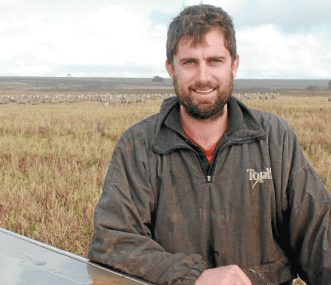Dohnes fit the bill at South Stirlings
TRAVIS KING Farm Weekly 31st August 2017
IN his own words Ashton Hood isn’t doing “anything too special” with the Dohne sheep flock he runs with his family at South Stirlings.
But the fact that they are looking to increase sheep numbers and are sticking with Dohnes after first trying them six years ago is a good sign.
“Prior to trying Dohnes we were buying in Merino ewes to produce prime lambs and six years ago we decided to move to a selfreplacing ewe flock,” Ashton said
“We were looking for something other than a Merino because it was around the time the live export industry was going through some turmoil.
“While we were looking for a breed that could satisfy our self-replacing need, we also wanted something that would produce lambs that appealed to the domestic market and wouldn’t compromise on the wool side of things too much.”
While building their pure Dohne ewe numbers up, the Hoods were still buying in ewes to mate for crossbred lambs.
“We were doing half and half, with our own ewes and buying in ewes to mate for lamb production,” Ashton said.
“This year will be the first year that we have mated all our own Dohne ewes and haven’t had to buy any in.”
Despite the choice to go into Dohnes being based more on a lamb production criteria, the fact that their wool is up there with Merinos is paying dividends.
“The money in wool is phenomenal at the moment and it is good that we were able to tap into that by running the pure Dohnes,” Ashton said.
“Wool prices look like they will hold up long term, so hopefully we can take advantage of that.”
South Stirlings farmer Ashton Hood is pretty pleased with a decision to switch to a self-replacing Dohne ewe flock six years ago.
The Hoods dropped their lambing back a couple of months this year, from May to July, and they will carry all the lambs through and shear them in January and February and sell them from there.
“We are probably a more prime lamb-focused operation but given the wool market at the moment we will target that more,” Ashton said.
They have no specific market for lambs, they just look to target the best price with wether lambs sold as prime lambs.
“Abattoirs certainly don’t have a problem with Dohne lambs – ours don’t have any issue finding buyers,” Ashton said.
“Generally the lambs make good weights without any extra feeding.
“We run a sizeable cropping operation in conjunction with the sheep, so the lambs have stubbles to go onto and they normally hit the weights pretty well without any extra help.”
Another benefit of the Dohnes according to Ashton comes at lambing time.
“They are very fertile and look after their lambs well,” he said.
“They seem hardier than a Merino and we generally hit 100 per cent lambing across the board without any extra effort.
“We are hoping by bringing lambing back to July that we might even lift that percentage down the track.”
Putting lambing back also meant there was a bonus in wool sales this year.
“We used to shear in August but have moved that to summer as it fits in better with the cropping system,” Ashton said.
“So we shore last August and then again in May as part of a gradual move to summer shearing.
“We didn’t have the length to do it in February this year, but it proved a good decision to delay it because we got good length in May and reaped the reward from a pretty high wool market.”
With a booming wool market, Ashton said they would probably revise their ram selection criteria.
They use rams from the Denvale and Kintail Park studs and will be looking for good wool traits even more than in the past.
“Initially we were looking for a bit more meat through our ram choice and there was always a focus on not losing wool quality, but we may swing down the wool quality line a little more this year,” Ashton said.
“We achieve pretty good wool cut now, averaging about 5-5.5kg a head, yearin, year-out.”
“One thing I have noticed in the six years since we went into Dohnes is that the genetics in the Dohne rams has really improved.
“There are some very good Dohne rams out there and a lot more of them.”
With a 2400 hectare cropping program comprising canola, barley and wheat, the sheep operation must fit in with it to a certain extent.
“We are running 2800 ewes at the moment, but will look to lift that to 3000,” Ashton said.
“The good thing about Dohnes is they are easy to manage and integrate well with the cropping program.
“Cropping is still our main focus but we do have about 900ha of pasture most years.
“We have grown serradellas in the past, but don’t have anything sown pasture-wise this year as the season has been pretty kind to us.”
Dohne ewes were in the middle of lambing on the Hood property in July, with this ewe having just given birth to twins.












 Facebook
Facebook YouTube
YouTube Instagram
Instagram